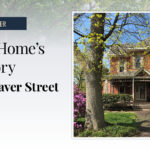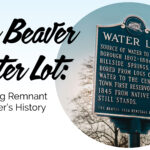Written by CHUCK COPELAND, Resident & Local Historian
From time-to-time people will ask me, “Why does BEAVER have so many brick sidewalks?”
The answer is: “It was the right material in the right place at the right time!”
Compared to most of the towns in Beaver County, Beaver was a little late getting developed. Even though Beaver was laid out in 1792 by Daniel Leet as a planned Commonwealth City, it really didn’t get its growth spurt until the 1870s and 80s. The late development is easily explained by the lack of water as an easily accessible resource. The town is built on an ancient alluvial floodplain composed of sand and gravel, making it difficult to dig a well that could hold water.
That brings us to the development of industrialized mining for both coal and clay. Even though Beaver had no basic industrial base in the 1870s, clay and coal mining became a huge industry in Beaver County. Every town surrounding Beaver had clay mines, and the clay was of unusually high-quality. Hand-thrown clay pots were manufactured in Vanport, Industry and Fallston. With industrialization, the clay mining business eventually grew into brick manufacturing.
With the arrival of the Pittsburgh-Lake Erie Railroad and Passenger service to Pittsburgh, Beaver was destined to become a middle-management bedroom community. Remember, it was already a planned community just waiting to be developed. It was at this time the borough decided to install separate sanitary and storm sewers, as well as water lines.
With all this new infrastructure, the town leaders decided to get out of the muddy streets of the time and install “state-of-the-art” brick streets and sidewalks. Middle management and upper management folks considered brick the finest material for building. The families who owned brickyards and lived in Beaver built their new homes to showcase their quality brick.
Because of these developments, Beaver County bricks achieved a reputation of being waterproof; it was a highly desirable, durable product standing up to Beaver County winters. The fact that Beaver County had mine shafts all around Beaver that produced not only coal but fire clay in the same shaft was quite a unique production benefit.
The waterproof brick led to another unique feature of Beaver homes: cisterns. Because Beaver’s water was always hard, most of the homes in Beaver were built with cisterns behind the house. The cisterns were built for collecting rainwater, which was soft and desirable for washing. Beaver bricks, which were waterproof, made an excellent choice for building brick cisterns.
Locally produced bricks had many uses, and were made in various shapes and sizes, depending on their final use. There was house brick, street brick, curb brick and decorative brick.
From the beginning, brick sidewalks were laid on the local sand, which was easily accessible, and in some cases not even washed. This was an adequate way to install bricks in the early days of horses and buggies. With the advent of cars and trucks in the early 1900s weights of vehicles doubled and sometimes tripled. This took its toll on the sand underlayment of the brick streets and sidewalks. The bricks themselves held up pretty well– however, since the sand underneath was soft, it would compress, and create undulations on the sidewalks and streets. Higher rates of traffic also increased speeds. To accommodate the automobile era, asphalt was laid over the brick streets to increase traffic flow. One drawback of asphalt is that it does not do well with a freeze thaw cycle, and so a new problem developed called potholes! Beaver did not have potholes prior to asphalt. Fortunately, we still have some of those original brick streets which do not require repaving! Yes, the undulations remain, but this feature does provide traffic calming.
The herringbone design used in Beaver’s sidewalks is not unique to Beaver, but it was popular in the Victorian era, and adopted to provide harmony and consistency throughout the town. This is why the herringbone design was selected in 2000 for the sidewalk renovation that took place for Beaver’s bicentennial streetscape.
Fortunately, brick sidewalks still remain in our town, and they are easily and economically repaired. Beaver’s Historical Architectural Review Board is working on a “how-to” video for Beaver residents. For more information, email HARB at HARB@beaverpa.us.
Chuck Copeland is a lifelong Beaver area resident, local historian, and former Beaver Borough manager, who has a great appreciation and depth of knowledge regarding all things Beaver!











